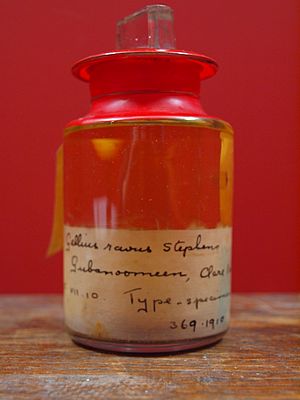Jane Stephens facts for kids
Quick facts for kids
Jane Stephens
|
|
|---|---|

Stephens c. 1920
|
|
| Born | 9 October 1879 Clontarf, Dublin, Ireland
|
| Died | 11 December 1959 (aged 80) Hospital of St John and St Elizabeth
|
| Alma mater | Royal College of Science for Ireland |
| Known for | Authority on Sponges |
| Scientific career | |
| Fields | Zoology |
| Institutions | National Museum of Ireland |
| Influences | Robert Lloyd Praeger, Robert Francis Scharff, H.J. Buchanan-Wollaston, James Nathaniel Halbert |
Jane Stephens (born October 9, 1879 – died December 11, 1959) was an important Irish zoologist. A zoologist is a scientist who studies animals. Jane was known as a top expert on sponges in Ireland. She also knew a lot about other sea creatures. She discovered and named more than 40 types of sponges that were new to science!
From 1905 to 1920, Jane worked at the Natural History Division of the National Museum of Ireland. She mainly studied collections of sea animals without backbones, like sponges. She also took part in the Clare Island Survey, which was a big study of nature in Ireland.
A famous scientist named Robert Lloyd Praeger said that most of what we know about sponges in Ireland is thanks to Jane's hard work.
Early Life and Education
Jane Stephens was born in Dublin, Ireland, in 1879. She was the sixth child in her family. Her parents, Albert and Jane Stephens, were Quakers. Her older sister, Laura Stephens, was also very smart and worked as a translator for the government.
Jane went to Alexandra College, where she was an excellent student. She was also good at sports like hockey and tennis. After college, she made history by becoming the second woman ever to earn a degree (a Bachelor of Science) from the Royal University of Ireland in 1903. She earned high marks in geology and biology.
Professional Career and Discoveries
In 1905, Jane started working at the Natural History Division of the National Museum of Ireland. She began as a Technical Assistant and later became an Assistant Naturalist.
Jane was a special expert in Porifera (sponges) and Cnidaria (like jellyfish and corals). She wrote many detailed scientific papers about the museum's collections. She also studied new specimens that were brought to the museum from different deep-sea explorations.
She identified 34 new species of sponges that were found during the Scottish National Antarctic Expedition. This was a big scientific journey to the Antarctic.
Jane also took part in the Clare Island Survey in 1909 and 1910. During this survey, she studied both freshwater and marine sponges, as well as other sea creatures without backbones. She worked closely with Eileen Barnes, an artist at the museum, who drew many of the illustrations for Jane's scientific publications.
Later Life and Legacy
In 1920, Jane Stephens married Robert Francis Scharff. He was the acting Director of the National Museum of Ireland at the time.
Back then, there was a rule in Ireland called the "marriage bar." This rule meant that women often had to leave their jobs when they got married. Because of this rule, Jane had to resign from her important job at the Museum. After she left her job, Jane stopped her scientific research, which was common for married women at that time.
Jane and Robert had one daughter named Marjorie Patience, who was born in 1921. Robert Scharff retired in 1921, and the family moved to Worthing, England. Robert passed away in 1934. Jane Stephens died in London in 1959.
Even though she was a very important scientist, there was no public tribute or obituary written for Jane after she died. This might be because many of the people she worked with during her 15-year career in Ireland, like Matilda Cullen Knowles, Eileen Barnes, and Robert Lloyd Praeger, had already passed away before her.


